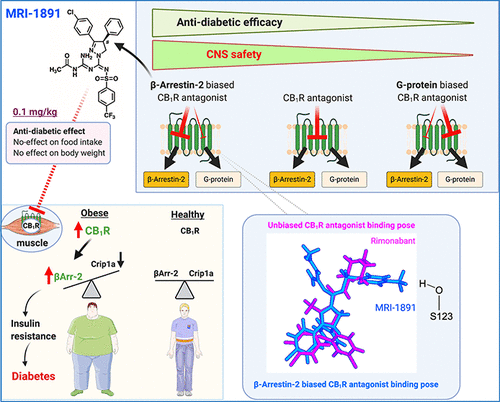当前位置:
X-MOL 学术
›
ACS Pharmacol. Transl. Sci.
›
论文详情
Our official English website, www.x-mol.net, welcomes your
feedback! (Note: you will need to create a separate account there.)
Functional Selectivity of a Biased Cannabinoid-1 Receptor (CB1R) Antagonist
ACS Pharmacology & Translational Science ( IF 4.9 ) Pub Date : 2021-04-08 , DOI: 10.1021/acsptsci.1c00048 Ziyi Liu 1 , Malliga R Iyer 1 , Grzegorz Godlewski 1 , Tony Jourdan 1 , Jie Liu 1 , Nathan J Coffey 1 , Charles N Zawatsky 1 , Henry L Puhl 1 , Jürgen Wess 2 , Jaroslawna Meister 2 , Jeih-San Liow 3 , Robert B Innis 3 , Sergio A Hassan 4 , Yong Sok Lee 4 , George Kunos 1 , Resat Cinar 1
ACS Pharmacology & Translational Science ( IF 4.9 ) Pub Date : 2021-04-08 , DOI: 10.1021/acsptsci.1c00048 Ziyi Liu 1 , Malliga R Iyer 1 , Grzegorz Godlewski 1 , Tony Jourdan 1 , Jie Liu 1 , Nathan J Coffey 1 , Charles N Zawatsky 1 , Henry L Puhl 1 , Jürgen Wess 2 , Jaroslawna Meister 2 , Jeih-San Liow 3 , Robert B Innis 3 , Sergio A Hassan 4 , Yong Sok Lee 4 , George Kunos 1 , Resat Cinar 1
Affiliation

|
Seven-transmembrane receptors signal via G-protein- and β-arrestin-dependent pathways. We describe a peripheral CB1R antagonist (MRI-1891) highly biased toward inhibiting CB1R-induced β-arrestin-2 (βArr2) recruitment over G-protein activation. In obese wild-type and βArr2-knockout (KO) mice, MRI-1891 treatment reduces food intake and body weight without eliciting anxiety even at a high dose causing partial brain CB1R occupancy. By contrast, the unbiased global CB1R antagonist rimonabant elicits anxiety in both strains, indicating no βArr2 involvement. Interestingly, obesity-induced muscle insulin resistance is improved by MRI-1891 in wild-type but not in βArr2-KO mice. In C2C12 myoblasts, CB1R activation suppresses insulin-induced akt-2 phosphorylation, preventable by MRI-1891, βArr2 knockdown or overexpression of CB1R-interacting protein. MRI-1891, but not rimonabant, interacts with nonpolar residues on the N-terminal loop, including F108, and on transmembrane helix-1, including S123, a combination that facilitates βArr2 bias. Thus, CB1R promotes muscle insulin resistance via βArr2 signaling, selectively mitigated by a biased CB1R antagonist at reduced risk of central nervous system (CNS) side effects.
中文翻译:

偏向大麻素 1 受体 (CB1R) 拮抗剂的功能选择性
七跨膜受体通过 G 蛋白和 β-抑制蛋白依赖性途径发出信号。我们描述了一种外周 CB 1 R 拮抗剂 (MRI-1891),其高度偏向于抑制 CB 1 R 诱导的 β-arrestin-2 (βArr2) 募集而非 G 蛋白活化。在肥胖的野生型和 βArr2 敲除 (KO) 小鼠中,MRI-1891 治疗可减少食物摄入和体重,即使在高剂量下也不会引起焦虑,从而导致部分大脑 CB 1 R 占用。相比之下,无偏见的全局 CB 1 R 拮抗剂利莫那班在两种菌株中都引起焦虑,表明没有 βArr2 参与。有趣的是,MRI-1891 在野生型中改善了肥胖引起的肌肉胰岛素抵抗,但在 βArr2-KO 小鼠中没有。在 C2C12 成肌细胞中,CB 1R 激活抑制胰岛素诱导的 akt-2 磷酸化,可通过 MRI-1891、βArr2 敲低或 CB 1 R 相互作用蛋白的过表达来预防。MRI-1891,但不是利莫那班,与 N 末端环上的非极性残基相互作用,包括 F108,以及跨膜螺旋-1 上的非极性残基,包括 S123,这是一种促进 βArr2 偏倚的组合。因此,CB 1 R 通过 βArr2 信号传导促进肌肉胰岛素抵抗,通过偏倚的 CB 1 R 拮抗剂选择性地减轻中枢神经系统 (CNS) 副作用的风险。
更新日期:2021-06-11
中文翻译:

偏向大麻素 1 受体 (CB1R) 拮抗剂的功能选择性
七跨膜受体通过 G 蛋白和 β-抑制蛋白依赖性途径发出信号。我们描述了一种外周 CB 1 R 拮抗剂 (MRI-1891),其高度偏向于抑制 CB 1 R 诱导的 β-arrestin-2 (βArr2) 募集而非 G 蛋白活化。在肥胖的野生型和 βArr2 敲除 (KO) 小鼠中,MRI-1891 治疗可减少食物摄入和体重,即使在高剂量下也不会引起焦虑,从而导致部分大脑 CB 1 R 占用。相比之下,无偏见的全局 CB 1 R 拮抗剂利莫那班在两种菌株中都引起焦虑,表明没有 βArr2 参与。有趣的是,MRI-1891 在野生型中改善了肥胖引起的肌肉胰岛素抵抗,但在 βArr2-KO 小鼠中没有。在 C2C12 成肌细胞中,CB 1R 激活抑制胰岛素诱导的 akt-2 磷酸化,可通过 MRI-1891、βArr2 敲低或 CB 1 R 相互作用蛋白的过表达来预防。MRI-1891,但不是利莫那班,与 N 末端环上的非极性残基相互作用,包括 F108,以及跨膜螺旋-1 上的非极性残基,包括 S123,这是一种促进 βArr2 偏倚的组合。因此,CB 1 R 通过 βArr2 信号传导促进肌肉胰岛素抵抗,通过偏倚的 CB 1 R 拮抗剂选择性地减轻中枢神经系统 (CNS) 副作用的风险。











































 京公网安备 11010802027423号
京公网安备 11010802027423号